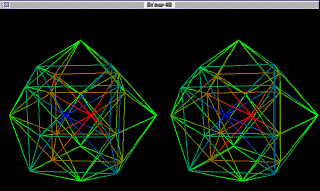

The above image is a 130k Mac GifBuilder animation of a 4-dimensional rotation of a 24-cell. It is a stereo pair that will (for many people) fuse into a 3-dimensional view of a 3-dim projection of the 24-cell. The colors code the 4th dimension: Green is the present; Red is the past; and Blue is the future. Things get blurry at the end of each loop, as the (interlaced) gifs are reloaded for each loop. It will loop forever on Netscape, so when you are tired of it, go back to the previous page, or click below to go to my Home Page.
If you want to see smoother animation, and can download and view a 742k Mac Quicktime .mov animation, HERE IS A MAC QUICKTIME .MOV. It can be played in a loop. The underlying graphics were generated by a C program written by Michael Gibbs, e-mail address JMTSGibbs@aol.com and WWW URL members.aol.com/jmtsgibbs/index.htm. He wrote a BinHex Mac version called Draw4D27.hqx. You can click to load it. If you do, you should also load: ReadMe4D, 24Cell, Hypercube, Cross, Simplex, Grid, 24vertex, LC24vertex, 45pt27ln, 135pt27ln, and 27-lineComments, which are text or data files to be put in the same Mac folder as Draw4D27.hqx. The total size of Draw4D27.hqx and the text and data files is about 130k. The animation shows different perspectives of the 24-cell, including but not limited to the one
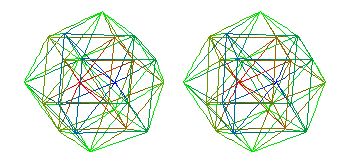
with a past vertex (1 vertex, present cube+octahedron+cube (8+6+8 vertices), and future vertex (1 vertex), in which the two sets of present cube vertices coincide, so that the present figure looks like a rhombic dodecahedron (the animated gif above is almost like it, but not quite, as the present and past cube vertices do not quite coincide so that the past and future vertices do not overlap). Two perspectives of the 24-cell are: which has a central 12-vertex cuboctahedron
and
which has a central 14-vertex rhombic dodecahedron
The 4-dimensional 24-cell, with 24 vertices and 24 octahedral cells, is the only self-dual and centrally symmetric real polytope in any dimension. The central cuboctahedral representation is dual to the central rhombic dodecahedral representation. The 48 vertices of both representations combined forms the 4-dimensional root vector diagram of the 52-dimensional exceptional Lie Group F4, which has fibration F4 / Spin(9) = OP2, the Octonion Projective Plane.
Here is a different perspective illustration, patterned after Fig. 172 of Geometry and the Imagination (Anschauliche Geometrie) by David Hilbert and S. Cohn-Vossen (Chelsea 1952), with 12 green vertices of a central cuboctahedron, 6 red vertices of an inner octahedron, and 6 blue vertices of an outer octahedron:
The Hilbert - Cohn-Vossen perspective is useful in understanding conformal graviphoton physics of the D4-D5-E6-E7-E8 VoDou Physics model.
Michael Gibbs also wrote versions of the polytope software in other computer languages, including DOS and Java, and his other versions generate some more polytopes,
including:
120-cell and
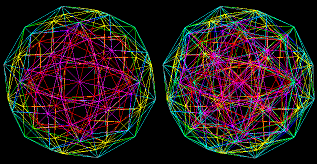
600-cell.
To see how this works, it is convenient to view the 24-cell from a perspective in which it has a past octahedron (6 vertices), a present cuboctahedron (12 vertices), and a future octahedron (6 vertices). This figure
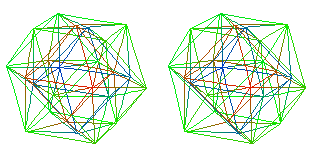
varies only slightly from that, so that the two octahedra in the figure do not overlap.
The 24-vertex 24-cell is made up of the 12-vertex cuboctahedron is the green central 3-dim cuboctahedron in the 3-dim hyperplane at 4th dim coordinate = 0
plus the blue (at 4th dim coordinate +1) octahedron and the red (at 4th dim coordinate -1) octahedron.
Now (not shown on the image) mark off Golden Ratio (in a consistent way) points on each of the 96 edges of the 24-cell.
The 24 vertices of the 24-cell plus the 96 Golden Ratio points should give you the 600-cell 4-dim polytope with 120 vertices, which is the 4-dim version of the icosahedron.
The 120 vertices of the 600-cell correspond to half (say, for example, the half in the Northern Hemisphere of a 7-sphere in 8-dimensional space) of the 240 vertices of the 8-dimensional real version of the Witting Polytope, where the 8-dimensional space is formed by considering the "square root of 5" part of the 4-dimensional coordinates as independent coordinates in 4 new dimensions.
The 24 vertices of the 24-cell correspond to the 24 dimensions of the Leech Lattice.
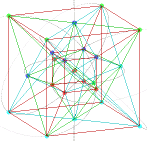
......